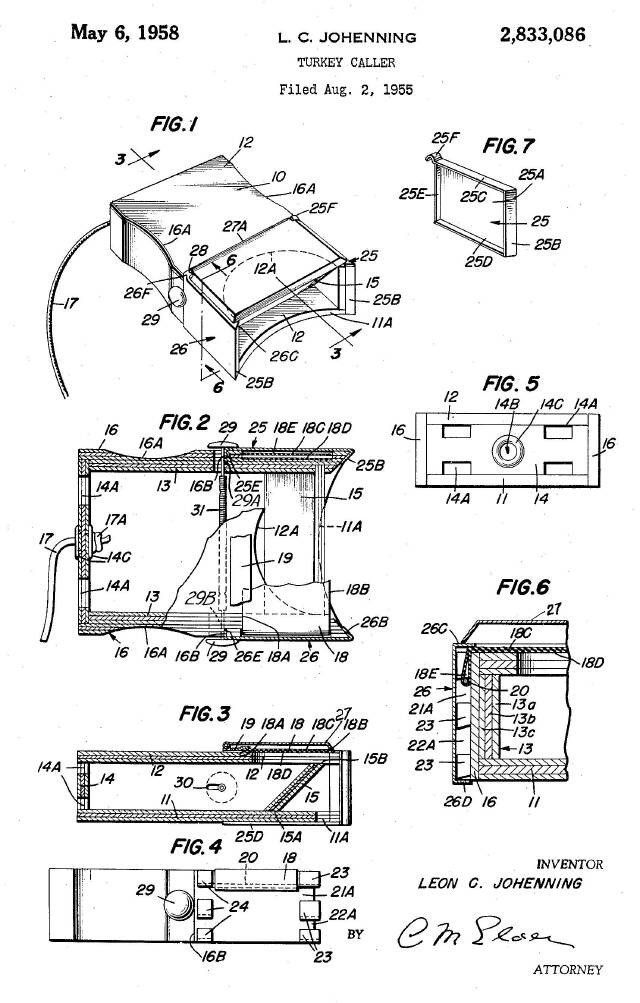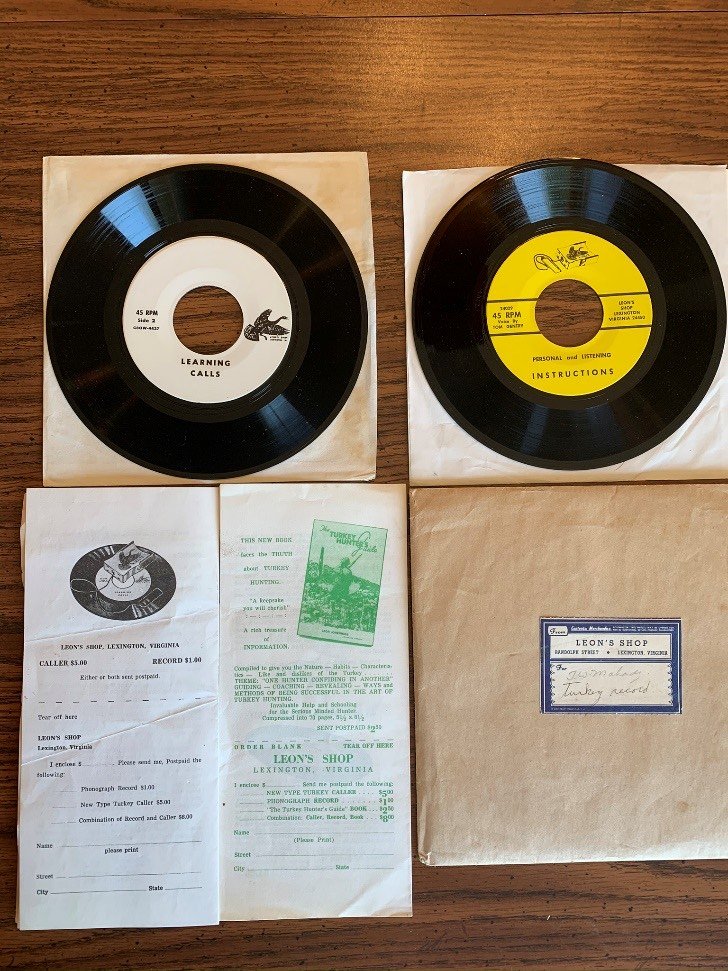a look back at a legend
By: Mr. Brent Rogers
I have used scores of turkey calls in my days afield, but every now and again I hear a call that grabs my attention. This past spring I fulfilled a years-long wish to hunt with my good friend, Marvin “Marv” Rooney, of Stillwater, Minnesota. A septuagenarian with decades of experience in the turkey woods, Marv was my original ‘turkey book mentor,’ and helped nurture my interest (and spend my money!) in good turkey hunting literature. I admit to lapses of ‘calling too much and too loud,’ but Marv’s old school and time tested ‘less is more’ approach works, given his precision in calling cadence and tone. The first call I heard him make on our hunt was a beautiful, single note on one of his old Johenning suction callers. And, yes, a gobbler sounded off in response!
Some of my favorite collecting pursuits are the assorted items from the talented men who ventured into multiple facets of the wild turkeys. Leon Johenning was one such, being a callmaker, author and producer of 2 records. Two excellent literature sources on Leon Johenning’s life and wild turkey pursuits are Earl Mickel’s Turkey Callmakers Past and Present, and Jim Casada’s Remembering the Greats. Both authors captured the essence of Johenning’s spirit and accomplishments in more detail than I can here. Johenning, of Lexington, VA, grew up hunting and bagged his first turkey at 9 years old. His service during WWII provided schooling and expertise on sound and vibration used to detect enemy subs.
Johenning was a fall turkey hunter, most typical of that time. Putting his knowledge of sound to work on turkey calls after the war, he experimented and sought to replicate the vibration and tone of the voice of wild turkeys. As any modern hunter should do, Johenning referenced his calls against live (domestic, in this case) turkeys. Another turkey hunter with decades of experience, Herb McClure is likely the living expert on Johenning. Some of you may recognize Herb from his 2012 book Native Turkeys and a Georgia Mountain Turkey Hunter. Johenning told Herb that using ‘breath-calling’ (in this case suction calling), the hunter can best put feeling and emotion into calls made.
Granted a patent in 1955 for his “Leon’s Turkey Caller,” Johenning caller is a box-diaphragm sporting a rubber diaphragm stretched and pinned across the call. Herb says that Johenning felt these materials provided more natural sound, vibration, and tone, as they best mimic biological parts. He told Herb his caller was on par with wingbone and trumpet calls in how turkeys perceived their realism. As someone that makes and uses my own wingbones (and many suction calls by more talented callmakers), I can attest to the distinct sound and results they provide. Since Johenning’s time, the synthetic materials used for diaphragms and tube calls have much improved, but if you have heard a Leon’s caller in the hands of someone familiar with it, you won’t soon forget it. Herb related that in 1964, a man named Bill Clements may have won a National Calling Contest in Yellville, Arkansas using the Leon’s Turkey Caller.
Leon’s “Turkey Caller” Patent, 1955
Having experimented with a Leon’s, I can say that it takes some practice, and that the membrane type and thickness, and its placement and tension are key variables. The Leon’s Turkey Caller went through several minor changes in parts and materials of constructions, and age of the callers can largely be determined by the color of the box they came in. This is approximate, but the first calls in the white box were made 1956-7, calls in the yellow boxes 1958-1967, calls in tan boxes 1968-1973, except for the latest calls in tan boxes which can be identified by calls which have brown vinyl over the side and top metal plates, which are from 1973-1988.
Turkey callmaking was a family business, with Leon’s family continuing to make calls for a while after his death in 1971. I was fortunate to be able to talk to Leon Johenning II, who is the son of the original callmaker, after my friend Wally Young connected us. Leon II and his mother were the ones that helped with and continued the callmaking for a few years. Leon II is admirable in his respect of the wild turkey, and provides the perspective that “we don’t as much hunt the wild turkey as cause him to hunt us.” For sure that is part of the challenge and thrill of turkey hunting, as we aspire to use our tactics and calls to lure in a wary bird. Being under the gaze of a scrutinizing gobbler is enough to make one squeeze the eyes to slits and freeze in place, all while the heart races and breaths become shallow.
Collectors would be wise to learn the distinction between the earliest calls that came in a white box, sometimes coined his ‘Christmas Box,’ not so much because the box is white as snow and the label has candy-cane-red print, but because it might be a box a treasured Christmas gift might come in (think of the slogan ‘a kiss begins with Kay’). Those earliest calls had a star stamped on the metal side plates (later models had 3 grooves instead), a rounded pin (later models had screws) and 4 holes on back of call (went to 2 in later models). The early pins actually connect to a spring inside the box and slide to release the side plates. Even the later model calls regularly sell for over $100! The best finds are the boxes that contain the original instruction booklets and advertising leaflets from “Leon’s Shop.”
L-R, top to bottom, a chronological progression of the Leon’s Turkey Caller
Reverse side of the L to R, top to bottom chronological view, with oldest caller at top left
Samples of some of the instructions and advertising leaflets Johenning included with his callers
Of the many Johenning Turkey Callers I have, this unique paper was glued in the box lid of one Caller
Another Johenning gem is the excellent book that he published. It has become very collectible. The Turkey Hunter’s Guide was first printed in 1962 and had 3 later printings that indicated what printing they are, but not the date printed (all just show the copyright date of 1962). Again, the first one is exceptionally rare and valuable. It can be easily recognized, as the cover sports a hunter carrying a turkey over his shoulder, whereas the 3 later printings all feature a walking turkey hen. A signed book is incredibly rare, and one to be treasured. I discovered after my friend Marv shared a signed Johenning book he had that the signature was considerably different than a signed book I have. After consulting with Leon II, the mystery was solved! Leon advised “My Father was right-handed and I am left-handed” and one can see the corresponding more far-right lean to Leon II’s signatures. Looking closely, you can see as well “II” attached to any of Leon’s II’s signatures.
Leon Johenning signature
Leon Johenning II signature
The four printings of Leon’s book, L-R, top to bottom, and with printings identified within.
Johenning also advertised and produced two 45-rpm records. I don’t know about you, but I love hearing the voices of dearly departed legends like Tom Turpin, Jack Dudley, Gene Nunnery, Ben Lee and Johenning on their records. Side 1 of the first record contained a demonstration of Leon’s Turkey Caller, and side 2 was “Learning Calls,” both narrated by Johenning. A Tom Gentry was the narrator for the later record, of which Side 1 was “Various hen and gobbler calls” and Side 2 was “Personal and Listening Instructions.” It is well worth your time to find a record player and listen in…and admit there is still something special about laying the needle on a vinyl disc.
The 2 Johenning records, showing front and back; note older one on left is red-white, newer red-yellow.
If you are looking for something different, whether that be a different sounding call, or experience in the turkey woods, I recommend you obtain and use a Leon’s Caller. Or pick up the book and sit at the feet of an old master. And get one of his record’s and listen to a voice from the past talk about the same wild turkey we revere yet today!
By: Brent Rogers









